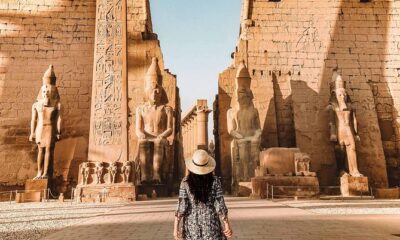Egypt
Egypt’s Rams Road: Then and Now

By Yara ELhemely
The Rams Road, also known as The Sphinx Avenue, is an ancient walkway, nearly two miles long and about 250 feet wide. It was once named “The Path of God”. It connects the famous Karnak and Luxor temples just up the Nile River to the North. This road is like a wide street with statues of sphinxes with the head of a ram along the way. The ram here symbolizes the deity Amun, the ancient Egyptian god of the air and one of the eight primordial Egyptian deities.
The Rams Road Then
The Rams Road was established in one of the most important celebrations of the ancient Egyptian calendar, the Opet Feast. The aim of the road was to witness the annual celebrations of the Opet Feast along with other special occasions, in addition to the coronation of kings, where ancient Egyptians would celebrate all the way from the Karnak Temple to the Luxor Temple.
Along the road, there are 1,200 statues. Each statue was carved from a single block of sandstone while having a cornice on which the name of the king, his titles, and praise are inscribed. Each statue is placed on a stone base on which some inscriptions are carved as well.
One interesting fact about this road is that it was totally buried under the sand for centuries with all of its statues. In 1949, Egyptian archeologist Zakaria Ghoneim discovered the first eight sphinx statues in front of the Luxor Temple. In a similar manner, efforts made to excavate and restore the site persisted, and since then, more statutes were unveiled throughout the years till 2006 when the entire road was uncovered.
The Revival
In order to completely revive this ancient road, it was necessary to remove all encroachments, which required a real political will because of the high cost of expropriating all of these properties, compensating their owners, and providing them with alternative places. Add to this the technical challenges to find and restore the ancient archeological road along with its rams, which were mostly in a bad condition.
Because of all these reasons, the project to revive the “Rams Road” was a dream that was difficult to achieve, until around two years ago, when the country decided to take on this great challenge and provide all the material and technical capabilities needed. That’s when the features of the ancient archeological road began to become clear.
So even though, the 3,400-year-old road has gone through several restoration efforts since being discovered, in November 2021, as a part of an ongoing push to promote archeological discoveries in Egypt, the “Kebash” or Rams Road was outstandingly renovated in an extravagant ceremony in Luxor after decades of excavation efforts.
The Ceremony
At the start of the spectacular ceremony, President Abdel Fattah El-Sisi marched down the road. Dr. Khaled El-Anany, Minister of Tourism and Antiquities, briefed the President on the details of the ceremonial opening of the Rams Road, which included pharaonic costumed participants, a symphony orchestra, lighting effects, professional dancers, boats on the Nile, horse-drawn carriages, and more.
During the event, three ceremonial songs were performed, as well as a screening of the documentary film (Luxor: The Secret), which depicted the city of Luxor and its most prominent monuments and tourist attractions.
Following that, Dr. Khaled Al-Anani, Minister of Tourism and Antiquities, delivered a speech in which he gave more information about the project and about Egypt’s efforts to maintain its place as a major touristic destination. Next, the Rams Road, which ran from the Luxor temple to the Karnak temple, was inaugurated in a replication of the ancient Opet Feast.
The hymns of Amun were played during an astonishing pharaonic parade, where performers arrived carrying three pharaonic golden boats, and at the same time fireworks were launched to light up Luxor’s sky.
The legendary opening ceremony concluded with the song (Luxor, Our Country), accompanied by more spectacular fireworks.
It is worth noting that the event was not simply a national ceremony; rather, approximately 200 international media correspondents accredited in Egypt attended this fictitious ceremony to cover it, and millions across the globe watched it. The success of this ceremony has led to a huge flow of tourists to Luxor, fully occupying all hotels in the city. Furthermore, the Opet Feast celebration has become an annual event to be organized and performed every year in the astounding Rams Road.




